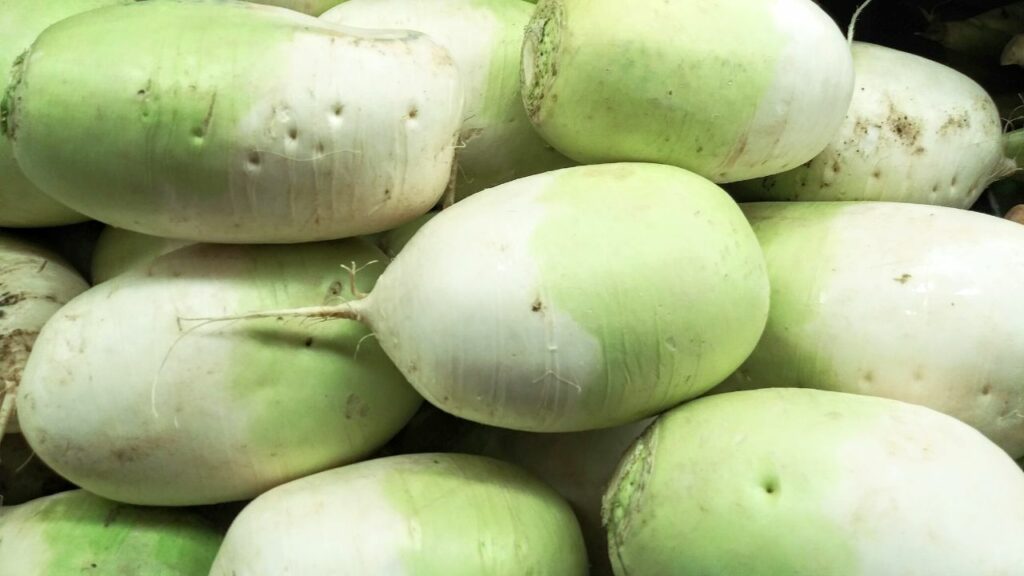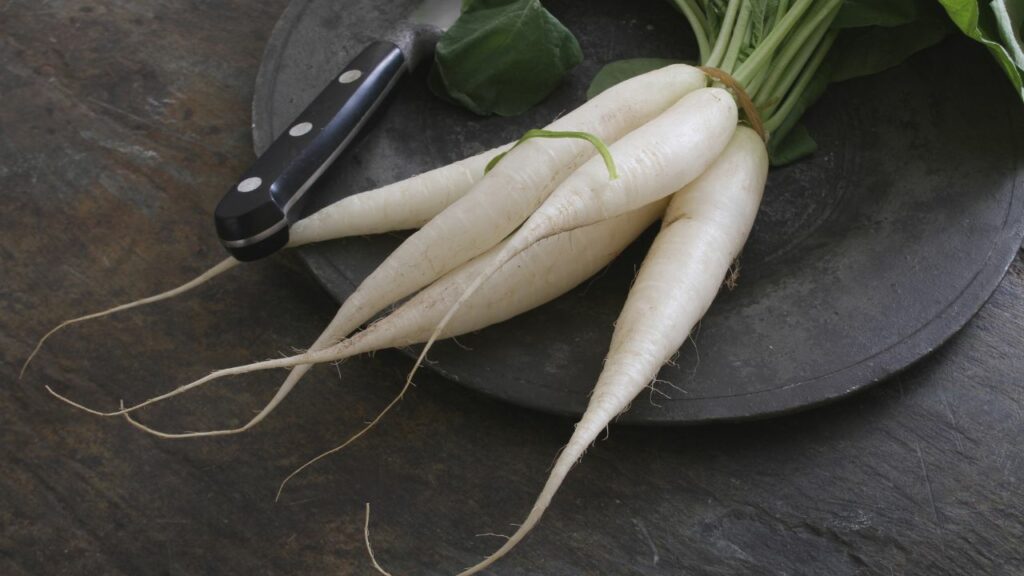|
Hey there, fellow culinary enthusiast! As you embark on this delectable journey through our articles, be prepared for a tantalizing adventure. Each click on our links could unveil delightful discoveries, possibly igniting your culinary creativity and, who knows, possibly adding a dash of sunshine to my day with a little commission from affiliate links. In other words, we sometimes earn a commission from partners listed. It's a win-win culinary rendezvous! |
Korean Radish and Daikon pose striking similarities because they can easily replace each other in any dish. It is because they both belong to the radish family and taste almost similar but not the same. A slight difference exists but is pretty subtle, and specific characteristics can help differentiate Korean Radish from Daikon.
You can differentiate the two only if you know what makes them different from each other. So today, this article will pinpoint the main differences between the two radishes and how you can know which Radish is Korean and which one is Daikon.
Contents
Korean Radish Vs. Daikon
Korean Radish and Daikon are white; however, Korean Radish has smaller bulbs than Daikon. On the other hand, Daikon is long and resembles carrots in length and shape.
Korean Radish is greener at the head. Korean Radish is firm and has a crunchier texture than Daikon. The leaves of Daikon are crunchier and firm than Korean Radish leaves. Korean Radish is more peppery and less sweet than Daikon.
We have further listed a few points of differentiation to help you distinguish the two.
Korean Radish Vs. Daikon Quick Comparison
Korean Radish and Daikon are root vegetables widely used in many Asian dishes.
The most significant difference is the origin of both radishes; Daikon belongs to Japan, whereas the Korean Radish, as the name suggests, is from Korea.
However, it isn’t easy to point out which of them is better because both are good in their way. Korean Radish is a type of Daikon, but its shape is similar to that of potato.
Korean Radish and Daikon are very different in taste, shape, texture, health benefits, and cooking techniques. Read the following table of comparisons that will help you differentiate the two.
| Features | Korean Radish | Daikon |
| Texture | Firm and Crunchy | Less crunchy than Korean Radish |
| Nutrients | ascorbic acid, vitamin B6, folic acid, magnesium, potassium, riboflavin, calcium and copper | Potassium, Calcium, Phosphorus, Magnesium, and Folate |
| Health Benefits | Assists in digesting starchy foods, detoxification, | anti-inflammatory, anti-bacterial, diuretic, good for the heart and stabilized blood pressure |
| Appearance | Short and thick like a potato | Elongated like a carrot |
| Flavor | Peppery and Sweet but less bitter | Intense and Tangy taste but less peppery |
| Storage | Store dry wrapped in a newspaper in refrigerator | Store in a damp cloth without washing in a refrigerator |
We hope this table helps you differentiate between Korean Radish and Daikon. Now let us explore more about the two Radish and which one should you prefer next time while cooking your favorite Asian dish.
Overview of Korean Radish and Daikon

Korean Radish is a part of the Daikon family originating from East Asia. It is cultivated in mass in the Korean peninsula.
The main difference between the Korean Radish and Daikon is their shape. The Korean Radish’s shape closely resembles a potato’s shape, whereas Daikon’s shape resembles a large carrot’s shape.
Korean Radish and Daikon can substitute for each other in various dishes. But before replacing one with another, go through the details below that tells how it tastes and which one is more beneficial than the other.
Korean Radish is an integral part of Korean family meals. It is firm, very crunchy, and resistant when cooked. It has an excellent acid-base balance, and even the leaves are edible. Korean Radish is mainly used in salads and side dishes, particularly in Kimchi.
Daikon is the parent vegetable of the Radish family. It has a smooth texture and tastes less peppery than Korean Radish.
The raw Daikon has a refreshing tanginess with a juicy crunch. Daikon tastes similar to turnips when cooked because its sweetness enhances with heat. Daikon is a nutritionally rich low-calorie vegetable with anti-bacterial, anti-inflammatory, and diuretic properties.
Read our article on Mei Fun Vs Lo Mein
Korean Radish Vs. Daikon (Detailed Comparison)
Daikon and Korean Radish belong to the same family but are different in many ways.
For example, they are different in shape, size, texture, appearance, taste, etc. Thus, even though they belong to the same family, they have distinct features.
Below is a detailed distinction between the two kinds of Radish that will help you differentiate the two from each other. Besides, it will also let you decide which one to use in which dish.
Texture
Daikon is white and elongated and has a striking resemblance to a giant carrot in terms of shape. It is thin-skinned and smooth in texture. Its napiform shape is round and thick at the top and pointed at the bottom.
Korean Radish is shorter and rounder compared to Daikon. The shape of Korean Radish is quite similar to that of a potato.
The neck of Korean Radish is green, and its texture is denser.
The flesh of Korean Radish is a pretty green color because of the presence of chlorophyll. The roots are creamy white.
Flavor
The flavor of any food is significant. It is the taste that attracts us to use a particular type. Though Korean Radish belongs to the family of Daikon, the taste of both vegetables is a little different.
A Daikon tastes like a red radish but is less intense and peppery in flavor.
On the other hand, raw Daikon has a rejuvenating tanginess with a juicy crunch. However, in cooking, it tastes similar to turnips because of its enhanced sweetness with heat.
Besides, Daikon is crunchy like a carrot and is used in salads and condiments for brightening meals.
Raw Korean Radish has a peppery taste with a tint of sweetness. However, good quality Korean Radish has more sweetness than bitterness.
Korean Radish can be consumed raw or cooked. Moreover, the spicy taste disappears when cooked.
Interesting comparison article – Chimichanga vs Burrito
Health Benefits
Korean Radish and Daikon have varied nutritional benefits. Read on more to determine which Radish is better for your health.
Daikon is a nutrition-rich low-calorie vegetable. It contains potassium and a small amount of calcium, phosphorous, folate, and magnesium. Though not rich in fiber, it has anti-inflammatory, anti-bacterial, and diuretic properties.

Besides, Daikon is very good for your heart and is known to stabilize blood pressure levels. Furthermore, it is rich in Vitamin C, which helps in boosting immunity.
Korean Radish is sold fresh and has a lot of folic acids, ascorbic acid, and potassium. Besides, it is also a good source of riboflavin, vitamin B6, copper, magnesium, and calcium.
Korean Radish also contains myrosinase, an enzyme assisting the digestive process with starchy food and helps in detoxification.
Korean Radish is also an excellent low, energy food that can benefit those on a diet.
Storage
Storing Daikon requires brushing off the dirt off the root. Therefore, you must not wash the Daikon before storing instead, wrap it in a damp towel and store it in the refrigerator.
Korean Radish also requires similar care for storing. However, they must not be wrapped in a damp cloth. Instead, one must use a newspaper for wrapping.
If your refrigerator has a crisp drawer, you must store these radishes there.
Final Verdict
Korean Radish and Daikon belong to the Radish family and are very similar. The significant difference is Daikon is mainly produced in Japan, whereas Korean Radish is a native of the Korean peninsula. Besides, they also differ in shape, texture, and taste.
Korean Radish is a little shorter and greener at the top, whereas Daikon is elongated like carrots. If you crave something peppery and crunchier then go for Korean Radish. However, if you want to eat something less crunchy and peppery but tangy, Daikon is your answer.
Even though belonging to the same family, Korean Radish and Daikon are rich in different sets of nutrients and offer different health benefits. Thus, both are beneficial and savor your taste buds in their own way.
Further reading – Do potatoes float?
Frequently Asked Questions
How to keep Daikon fresh after cutting?
Daikon can last long in your refrigerator, even after cutting. All you need to do is wrap the leftover pieces in plastic wrap or put it in a plastic bag. However, to store sliced Daikon, you must bear the foul smell that comes complimentary with it.
Is Daikon a Korean Radish?
The Korean Radish is a kind of Daikon. The Korean Radish is mainly cultivated in Korea, whereas the Daikon is mainly cultivated in Japan.
Can Daikon substitute Korean Radish in a dish?
Daikon is a suitable replacement for Korean Radish. It is less crunchy than Korean Radish. However, if you want something crunchier, you can opt for jicama or water chestnuts.
How long can you preserve Korean Radish in a refrigerator?
The Korean Radish lasts for 2 weeks in a refrigerator. To preserve Korean Radish in a refrigerator, you need to wrap it either in a plastic bag or a newspaper and preferably store it in a crisp drawer.
Conclusion
Korean Radish and Daikon are a part of the same Radish family. The only thing that differs between them is the crunchiness in taste and size in appearance. Both are good dietary vegetables rich in a different set of nutrients.
Thus, you can substitute Korean Radish and Daikon as per your requirement. However, the result should always be something that you like in taste.

